What Is the 1944 Lincoln Wheat Penny Made Of?
Are you a numismatist or coin trader? If yes, you should look at the 1944 Lincoln Wheat penny.
A 1944 Lincoln Wheat Penny is an antique coin worth more than its face value. So, if you want to purchase a coin, this particular coin ought to be included in your collection.
One of the most iconic pieces of US currency is the Lincoln Wheat Penny, which has been issued by the US Mint beginning in 1909 up to this day. It was crafted to commemorate the 100th birth anniversary of Abraham Lincoln, the 16th President of the United States of America.
While looking for a talented sculptor, President Roosevelt discovered a medal created by Victor Brenner for the Panama-based Canal Commission. Roosevelt asked who designed the medal because he was impressed by the award.
There was growing pressure to produce a Lincoln coin as his 100th birth anniversary drew near. As a result, Victor Brenner was formally engaged by the US Mint to create a coin in honor of Abraham Lincoln. The US mint chose Victor Brenner’s design after receiving various suggestions, and its debut was scheduled for July 1909.

Regarding the design, you will see Lincoln’s image on the obverse facing to the right. Inscriptions also include “IN GOD WE TRUST” arching on top of the head of Lincoln. On his backside is the word “LIBERTY,” which is an important value for many Americans. Then, in front of Lincoln is the year 1944.
On the reverse side, you’ll find two stalks of wheat. This gives the name of the coin, the “Wheat Penny.” Wheat symbolizes the agricultural origin of the United States and how so many people worked hard to build this country into what it is today.
Inscriptions on the reverse side of the 1944 wheat penny include E PLURIBUS UNUM, a US motto, meaning out of many, one. The other inscriptions include ONE CENT and UNITED STATES OF AMERICA.
The 1942 Lincoln Wheat Penny’s history started thirty years before it was formally released. President Theodore Roosevelt expressed concern about the American coinage’s lack of artistic appeal in 1904. Therefore, it was crucial to make the current coinage more attractive.
There was no congressional prohibition against redesigning existing coins. Augustus Saint-Gaudens, an American sculptor, was hired for the job by the President via the US mint. Unfortunately, Saint-Gaudens died before completing the project, but the US mint continued and finished it in 1908.
1944 Lincoln Wheat Penny Varieties
There were different minor and major varieties of the Lincoln wheat penny in 1944. The major ones include the 1944-P, 1944-D, and 1944-S pennies. The minor ones include pennies made with steel from the three mint centers. Aside from that, there are also error coins from this Lincoln series. Chief among them is the 1944-D/S 1-cent coin.
Here’s a quick look at the mintage figures of the major 1944 Lincoln Wheat penny varieties:
| Variety | Location | Mintage |
| 1944-P Lincoln Penny | Philadelphia | 1,435,000,000 |
| 1944-D Lincoln Penny | Denver | 430,578,000 |
| 1944-S Lincoln Penny | San Francisco | 282,760,000 |
| Total | 3,098,454,600 |
The primary difference among these varieties is their mint mark. Those coins made in Denver bear the D mintmark and S for San Francisco. Coins struck in the Philadelphia Mint don’t have a mintmark.
With that said, let’s go through each of these varieties and learn more about them.
1944 D Lincoln Wheat Penny
Edge: Smooth
Mint Mark: D
Place of minting: Denver
Year of minting: 1944
Face Value: $0.01 (one cent)
Price: $0.96 to $4.52 (circulated condition)
Quantity produced: 430,578,000
Designer: Victor D. Brenner
Composition: 95% copper and 5% tin and zinc
Mass: 3.11 grams
Diameter: 19 mm
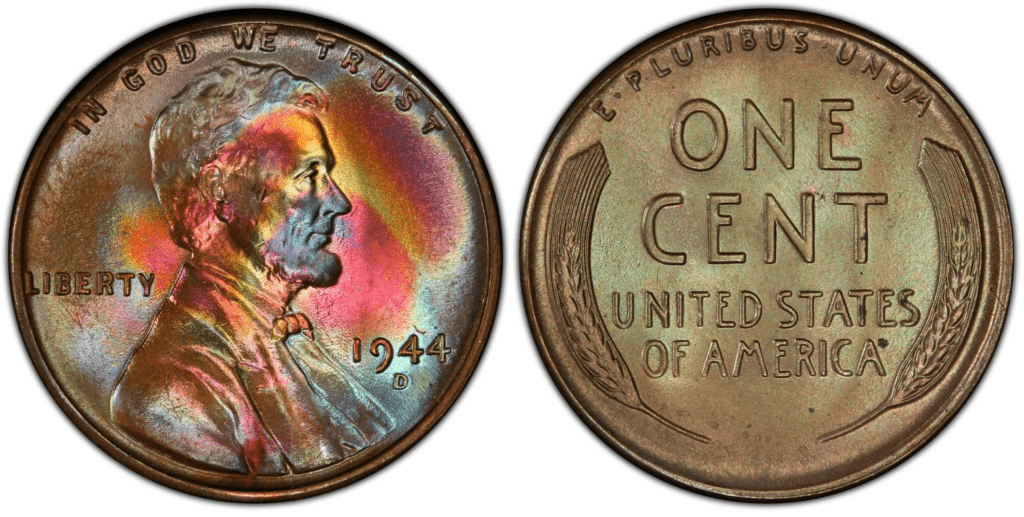
The 1944-D wheat penny was properly made. This means that the Denver Mint used high-quality die. Thus, you should be able to find 1944 pennies that are still in good condition.
There were more than 430 million 1944 pennies. If you find one in a circulated condition, you might be able to sell it for $0.96 to $4.52.
1942 P Lincoln Wheat Penny
Edge: Smooth
Mint Mark: none
Place of minting: Denver
Year of minting: 1944
Face Value: $0.01 (one cent)
Price: $1.13 to $5.70 (circulated condition)
Quantity produced: 1,435,400,000
Designer: Victor D. Brenner
Composition: 95% copper and 5% tin and zinc
Mass: 3.11 grams
Diameter: 19 mm
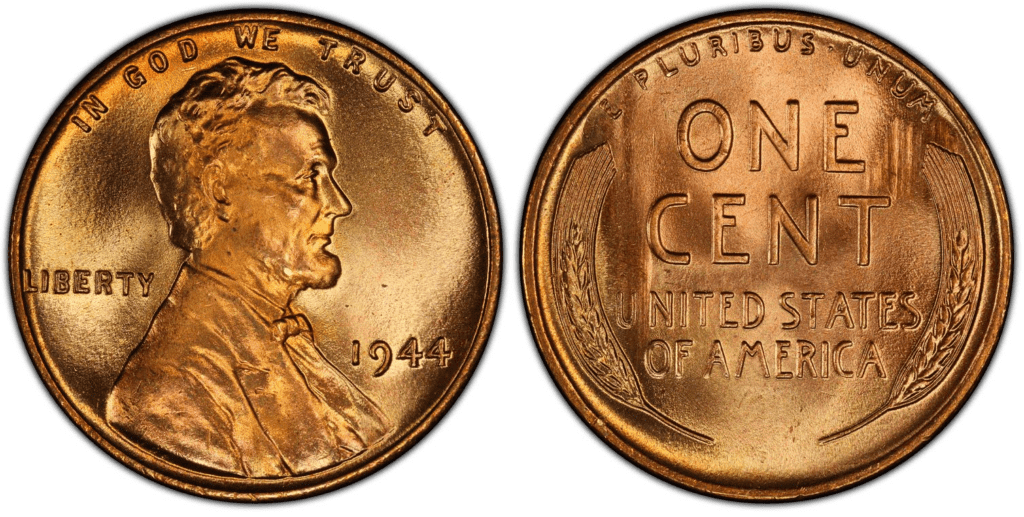
The 1944-P was the most abundant variety for this Lincoln series, reaching more than 1.4 billion issued coins. This is a record-breaking feat by the Philadelphia Mint since it was the first time a US Mint produced more than a billion coins in one year.
This would not be the only year because, in 1945, 1956, and 1957, there would be another mintage figure higher than 1 billion by Philadelphia and other mints.
1944-P wheat pennies could be sold between $1.13 to $5.70 in circulated condition and more if it is in better condition.
1942 S Lincoln Wheat Penny
Edge: Smooth
Mint Mark: S
Place of minting: San Francisco
Year of minting: 1944
Face Value: $0.01 (one cent)
Price: $0.96 to $4.52 (circulated condition)
Quantity produced: 282,760,000
Designer: Victor D. Brenner
Composition: 95% copper and 5% tin and zinc
Mass: 3.11 grams
Diameter: 19 mm
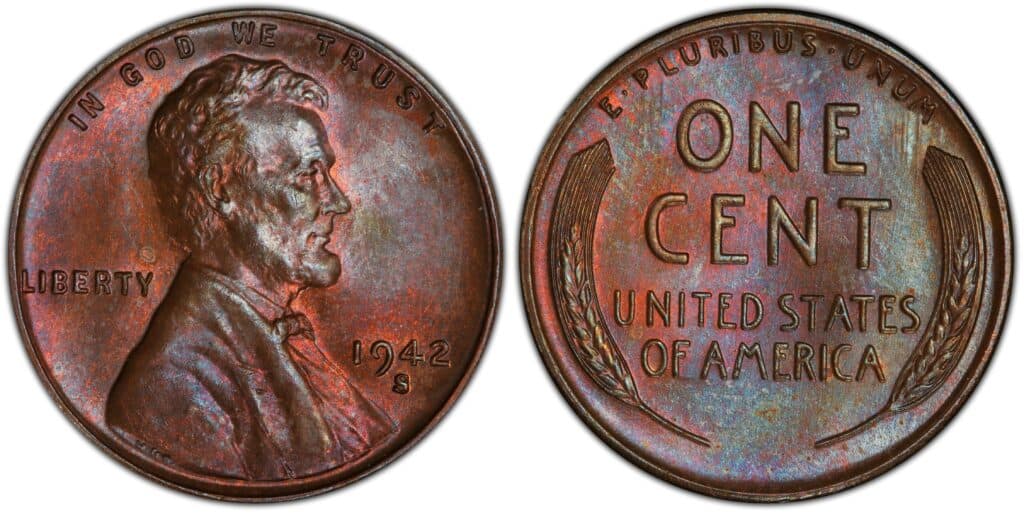
The San Francisco Mint produced more than 282 thousand wheat pennies in 1944. While that might already be a high mintage figure, it could have been higher. The SF Mint stopped producing wheat pennies in the middle of the year to prepare for the production of Philippine one-centavo coins.
According to numismatists, the 1944-S pennies are quite common in fully red gem condition. However, you might still want to carefully examine the penny you’re interested in and ensure no signs of die erosion.
List Of 1944 Lincoln Wheat Penny Errors
There were more than 3 billion wheat pennies produced in 1944. So, it’s not surprising to know that there are some Lincoln pennies that were struck with errors.
It is important to note that 1943 was the only time the pennies were made with zinc steel. That’s why, in 1944, there were a few 1944 pennies that still used blank steel planchets.

Here’s a quick look at the 1944 steel pennies’ mintage:
- 1944-P zinc plated steel – 27 known examples
- 1944-D zinc plated steel – 7-10 known examples
- 1944-S zinc plated steel – 1-2 known examples
Moreover, the most known coin error for this series is the D/S error. In this error, the mint mark D was repunched over the S mint mark.
Here’s how it looked:
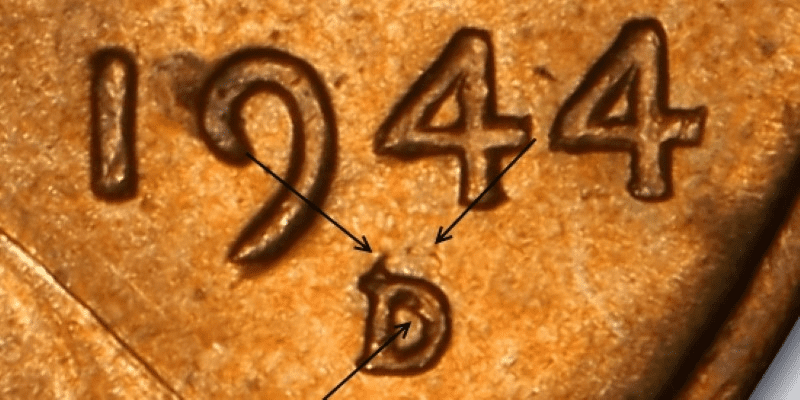
You can see a small portion of the letter S on the image. This happened when some planchets with the S mark from San Francisco were transported to the Denver Mint. According to some estimates, there are about 120 examples of these coins in existence today.
Aside from these errors, there are uncommon errors. For example, is the cud error. Here’s what it looks like:
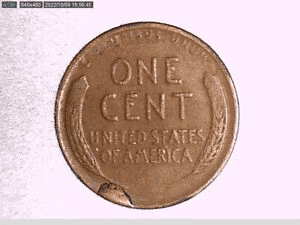
A cud error happens due to a die defect, which results in the coin having a raised portion on its surface, as shown above. There’s also the doubled die error when the planchet is hit by the die twice, resulting in a doubling of one or more elements of the coin’s inscription.
Lamination errors also happened in the production of the 1944 wheat pennies. The coin’s metal composition was mixed with foreign material in this error. So, when the penny cooled down, the foreign material caused the coin to peel or crack.
Here’s an example of a lamination error:
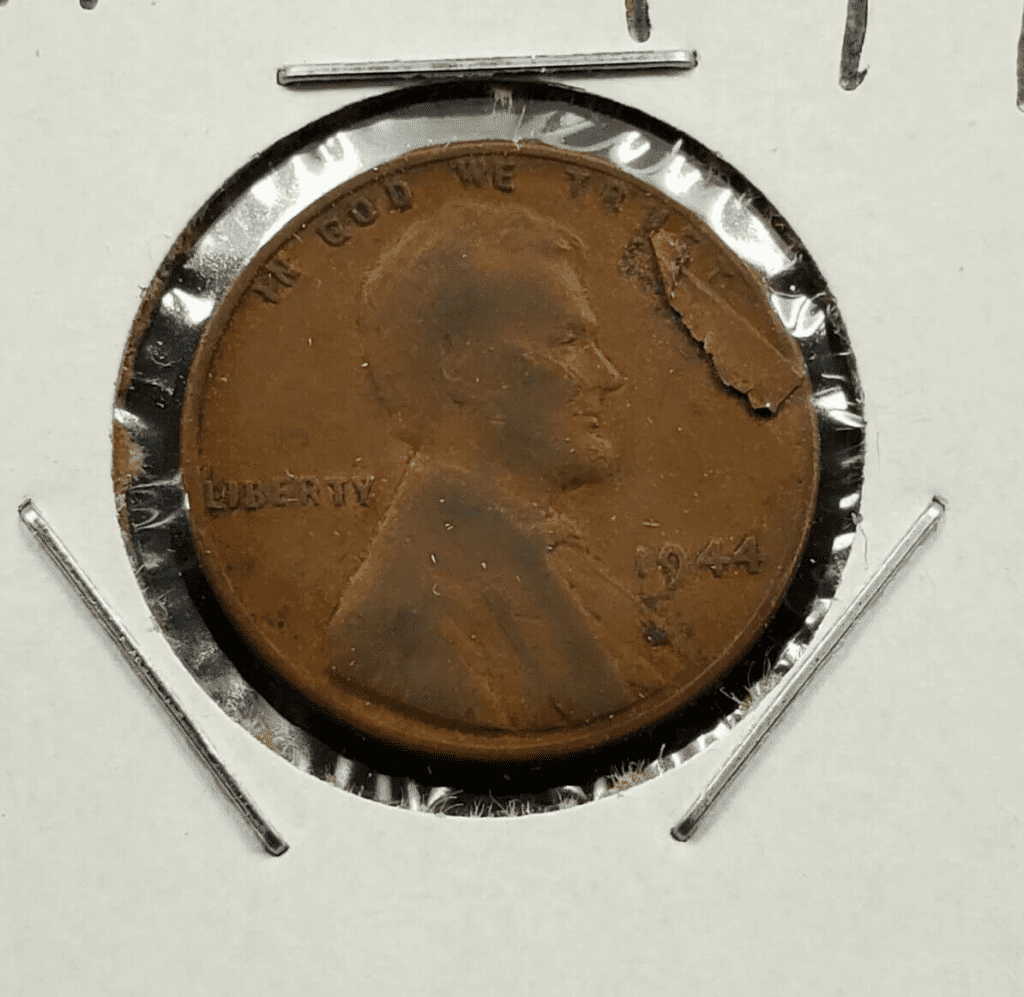
While yes, the US Mint doesn’t want any error coins to occur, a lot of coin collectors are super interested in these types of coins. After all, error coins look so interesting and unique as well.
How Much Is The 1944 Lincoln Wheat Penny Worth Today?
The face value of the 1944 Lincoln penny is only 1 cent. The melt value of the 1944 Lincoln wheat penny is not that high, reaching up to $0.0254.
Now, you might ask, it is still worth it to keep or buy a 1944 Lincoln wheat penny? The answer is definitely yes. Why? Because the true value of the wheat penny doesn’t rely on its face value or melt value.
To get an idea of how much the 1944 wheat 1-cent coin could be priced in the market, here’s a values chart:
| Coin | Condition | Grade | Mintage | Value |
| 1944 D Lincoln penny | Circulated/mint | Not graded | 430,578,000 | $0.96 to $4.52 |
| 1944 D Lincoln penny | Uncirculated/mint | MS-66 | 430,578,000 | $28 to $60 |
| 1944 D Lincoln penny | Uncirculated/mint | MS-67 | 430,578,000 | $70 to $227 |
| 1944 D Lincoln penny | Uncirculated/mint | MS-68 | 430,578,000 | $2,160 |
| 1944 P Lincoln penny | Circulated/mint | Not graded | 1,435,400,000 | $0.96 to $4.52 |
| 194 P Lincoln penny | Uncirculated/mint | MS-65 | 1,435,400,000 | $8.50 |
| 1944 P Lincoln penny | Uncirculated/mint | MS-66 | 1,435,400,000 | $12 |
| 1944 P Lincoln penny | Uncirculated/mint | MS-67 | 1,435,400,000 | $25 |
| 1944 S Lincoln penny | Circulated/mint | Not graded | 282,760,000 | $0.96 to $4.52
|
| 1944 S Lincoln penny | Uncirculated/mint | MS-65 | 282,760,000 | $15 to $16 |
| 1944 S Lincoln penny | Uncirculated/mint | MS-66 | 282,760,000 | $12 to $35 |
| 1944 S Lincoln penny | Uncirculated/mint | MS-67 | 282,760,000 | $71 to $312 |
| 1944 P Steel | Uncirculated/mint | MS-64 | Around 27 examples | $5,600 to $48,000 |
| 1944 D Steel | Uncirculated/mint | MS-63 | Around 7-10 examples | $79 to $115,000 |
| 1944 S Steel | Uncirculated/mint | MS-66 | Only one known example | $373,750 to $408,000 |
As you can see, the 1944 wheat penny can be tremendously expensive, especially when they are rare and still in good condition at the same time.
How Does The Grading System Work?
The Sheldon Scale is used by numismatists to provide a numerical value to coins. The Sheldon Scale goes from poor (P-1) to perfect mint state (P-1) (MS-70). Coins were originally evaluated using words to reflect their condition (Good, Fair, Excellent, Etc.). Unfortunately, coin collectors and dealers had different ideas about what each of these terms represent.
Professional numismatists joined together in the 1970s and established CoinGrading standards. These numismatists now assign grades at key places on the seventy-point scale, using the most regularly utilized numeric points in conjunction with the original adjective grade. The following are the most common coin grades:
-
-
- (P-1) Poor – Indistinguishable and probably damaged; if used, must have a date and mintmark; otherwise, rather battered.
- (FR-2) Fair – Nearly smooth, but without the damage that a coin graded Poor often possesses. The coin must have enough detail to be identified.
- (G-4) Fair – Inscriptions have merged into the rims in some areas, and important elements have been mostly erased.
- (VG-8) Very Good- A little weathered, but all of the primary design elements are visible, albeit faintly. There is little if any, central detail left.
- (F-12) Good – The item is very worn, yet the wear is even, and the overall design details stand out clearly. Rims are almost completely isolated from the field.
- (VF-20) Very Fine – Moderately weathered, with some finer features still visible. The motto or all letters of LIBERTY are readable. Both sides of the coin have entire rims that are separated from the field.
- (EF-40) Extremely Fine – Gently used; all gadgets are visible, and the most important ones are bold. The finer details are bold and clear, however, light wear may be seen.
- (AU-50) Uncirculated – Slight evidence of wear on the coin’s design’s high points; may have contact marks; eye appeal should be adequate.
- (AU-58) Uncirculated Choice – Slight traces of wear, no severe contact marks, almost full mint shine, and great eye appeal.
- (MS-60) Mint State Basal – Strictly uncirculated; no indication of wear on the coin’s highest points, but an unsightly coin with reduced luster, visible contact marks, hairlines, and other flaws.
- (MS-63) Mint State Acceptable – Uncirculated, but with contact scratches and nicks, little reduced shine, but otherwise appealing appearance. The strike is weak to average.
- (MS-65) Mint State Choice – Uncirculated with great mint shine, very little contact blemishes, and exceptional eye appeal. The strike is unusually severe.
- (MS-68) Mint State Premium Quality – Uncirculated with superb luster, no obvious contact marks to the naked eye, and exceptional eye appeal. The strike is quick and appealing.
- (MS-69) Almost Perfect Mint State – Uncirculated with perfect brilliance, a sharp and appealing strike, and extremely good eye appeal. A near-perfect coin with minor imperfections in the planchet, strike, and contact markings (seen only under 8x magnification).
- (MS-70) Mint State Perfect – Under 8x magnification, there are no tiny imperfections discernible; the strike is crisp, and the coin is perfectly centered on a beautiful planchet. Rarely seen on a coin, this coin is bright and whole, with original luster and exceptional eye appeal.
-
Are There Any Rare 1944 Lincoln Wheat Penny?
There are rare 1944 Lincoln wheat pennies, and these are the pennies that you should watch out for. Wheat pennies with a grade of MS68 and above are considered rare since there are just so few to no examples that exist today.
Another rare 1944 Lincoln pennies would be the 1944-S 1-cent steel penny. These pennies exist because the San Francisco Mint accidentally struck the 1944 penny into zinc-coated steel. Today, there were only 2 of these coins known to exist. To give you an idea of its value, the auction record as of 2021 is $408,000.
There were also zinc-plated steel pennies that were struck in Denver and Philadelphia. Since there are just less than 40 examples of them, they are considered rare.
Aside from the steel pennies, the D over S mintmark error of the 1944 wheat pennies can be considered rare. Some appraisers mentioned that there are about 120 of these error coins have already been discovered.
Where To Buy Or Sell 1944 Lincoln Wheat Penny?
The 1944 Lincoln wheat pennies are available online and offline. You can go straight to Amazon, eBay, and Etsy to buy and sell these pennies. There are also special websites that focus more on coins. You can simply do a Google search, and you’ll find them.
You can try social media, online forums, and other marketplaces to find 1944 Lincoln wheat pennies.
If you want to see, touch, and really appreciate a coin you want to buy, then you can visit shops in person. Some ideas would include coin shops, antique stores, and pawnshops.
FAQs
Why is the 1944 wheat penny rare?
The 1944 wheat penny is rare when it is in great condition and possesses unique attributes. For example, the 1944 pennies struck on zinc-plated steel are considered rare since about a hundred exist. 1944 pennies with a grade of at least MS68 are considered rare. Since 1944 pennies are already old, then they become rarer as time passes by.
How much is a 1944 D wheat penny worth today?
The price of a 1944 D wheat penny depends on its condition and grade. Pennies that entered the circulation would just be about less than $1. However, rare 1944 D pennies can be more expensive. To give you an idea, the auction record of a 1944 D penny with a genuine rating is $22,425.
Which 1944 penny is worth a lot of money?
The 1944 penny that is worth a lot of money is the 1944 steel pennies. A 1944-S steel penny was sold for $408,000; 1944-D for $115,00; and 1944-P for $180,000.
Is a 1944 penny supposed to stick to a magnet?
If the 1944 penny was made of steel, it should stick to a magnet.
